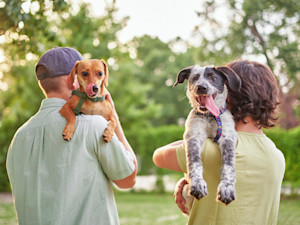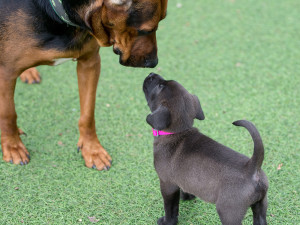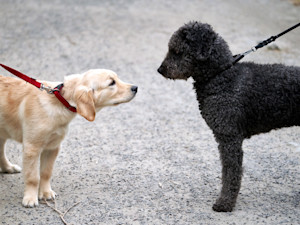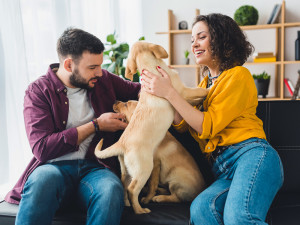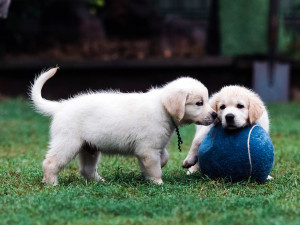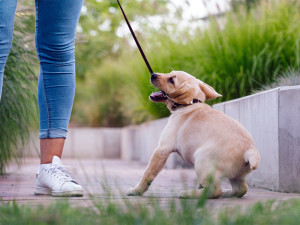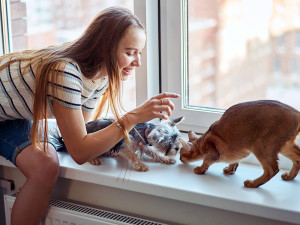How to Introduce a Puppy to a Dominant Dog
Here are the steps you should take.
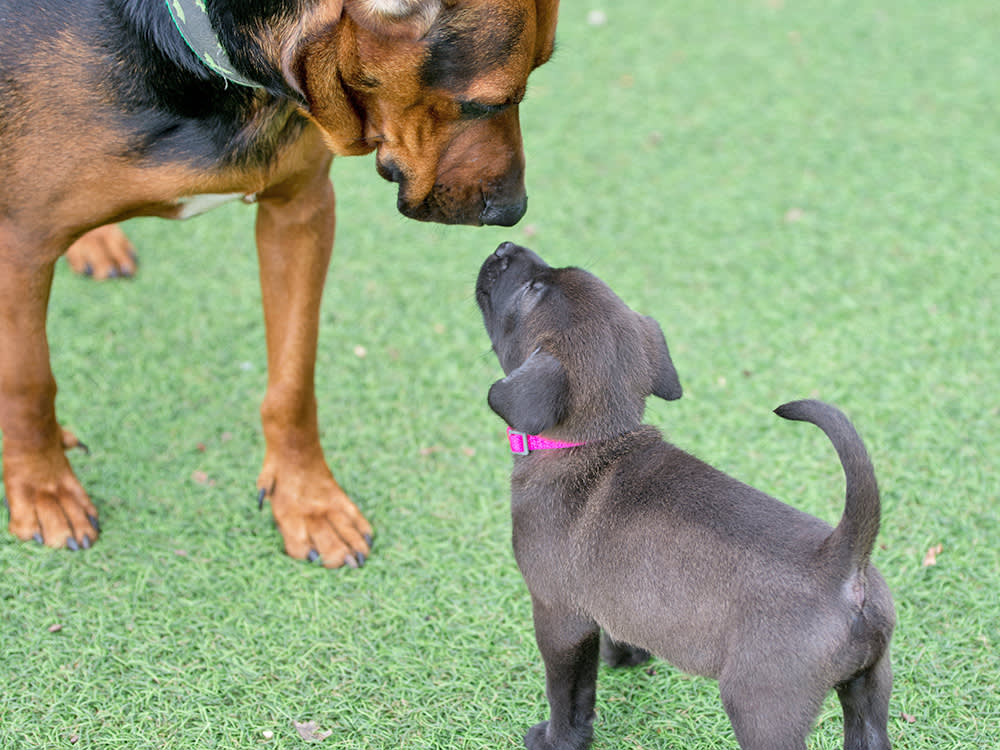
Share Article
In This Article:
What’s the Best Way to Introduce a Puppy to a Dominant Dog?opens in a new tab Why Is It Important to Introduce Your New Puppy to Your Dominant Dog Properly?opens in a new tab Step-By-Step Guide to Introduce Your Puppy to Your Dominant Dogopens in a new tab Strategies for a Successful Introduction to Your Dominant Dogopens in a new tab How to Handle Aggressive Behavioropens in a new tab Frequently Asked Questionsopens in a new tab
Bringing a new puppy into a home is a big undertaking when it comes to training. But if you have another dog that adds another layer to welcoming a puppy into your home. It can be intimidating to introduce a puppy to a dominant dog, so you want to make sure you do it in the right way that’s good for both dogs.
Note that in modern training, behaviorists have disproved the dog dominance theoryopens in a new tab; they don’t operate by hierarchal pack rules. In other words, they don’t operate by rules that one dog is superior to another, and they don’t think of themselves as superior to their humans, either. So, for the purpose of this article, we refer to the dominant dog as the pup who is older, trained, and may have established relationships with the humans in the environment.

littleKin™ is Kinship’s home just for puppy and kitten parents. Bop over to check out expert advice, new pet tools, and special deals—all curated for your newest family member.
opens in a new tabWhat’s the best way to introduce a puppy to a dominant dog?
You want to be able to prepare first to introduce a puppy into your home. To help the more dominant dog, you want to put anything that they might guard into one spot to avoid any conflict with a new puppy. Vice versa goes for the new puppy, you want to make sure all their things are in their own area. According to dog trainer and owner of Another Chance Trainingopens in a new tab, Shir Limazati, having the right location for the introduction is key.
“Introducing a puppy to a dominant dog needs to be done with caution and in neutral territory. Meaning, the introduction is best done not on the dominant dog’s turf,” she says.
Why is it important to introduce your new puppy to your dominant dog properly?
Having a proper introduction is important in order to avoid aggression or territorial issues between the dogs, which could cause stress between them. A gradual introduction helps them to build a positive relationship.
Will a dominant dog accept a new puppy as a member of the pack?
Again, it all depends on the introduction. A dominant dog will accept a new puppy into the pack if the introduction is done properly by giving them time and space to get to know each other and following specific guidelines.
Step-by-step guide to introduce your puppy to your dominant dog
There are helpful steps to go through to make sure that introducing your puppy to your other dog goes smoothly.
Prepare for the introduction.
Preparing for the introduction is key. You first want to make sure the dogs come to a neutral spot to meet for the first time. Bringing a friend or family member so there’s attention for both dogs is important as well.
Make the initial introduction.
Try bringing the dogs together and let them greet each other naturally. Limazati mentions paying attention to the leashopens in a new tab is important. “Leave the leashes on the dog and the puppy and you can drop the leash so they can meet each other with no tension on the leash in the enclosed outdoor space.”
Carefully monitor behavior.
Let the dogs do their own thing but be sure to monitor their behavior for signs that they aren’t getting along so you can separate them immediately. Be sure to reinforce positive behavior when they are getting along.
Establish a new routine.
Maintaining a new routine in order to make sure their continued introductions go smoothly is imperative. And keep those in neutral spaces until it’s clear that the dogs are getting along.
Repeat short introductions until both dogs are comfortable.
Keep making short introductions and constantly monitor their interactions together until the dogs feel comfortable with each other.
Strategies for a successful introduction to your dominant dog
There are many strategies to use when introducing your dominant dog to a new puppy in the household.
Have them meet in neutral territory.
Having the dogs meet in an area that is not special to either of them is important so neither feels territorial about their surroundings. In other words, don’t introduce your new puppy to your existing dog in your backyard, which your dog probably considers theirs.
Take parallel walks.
Having both dogs walk alongside one another at a comfortable distance is a good way for the dogs to get to know another in a neutral way. “I always recommend first going for a walk with the dog and the puppy in a place that’s new to the dominant dog. If the walk goes well, you can then go to an enclosed outdoor space that is again neutral to the dominant dog — a backyard that is fenced that is not a place the dominant dog usually plays,” Limazati says.
Have them meet in a controlled setting.
Making sure the setting where the dogs are meeting is very important. Again, that’s why having neutral territory is important. Limazati also notes that you want to make sure there’s nothing either will feel any ownership over.
“You want to make sure there are no high value items left out — no bones, special toys, and absolutely no food bowls. Water is usually OK.” You’ll also want to be sure to monitor the behavior of both dogs and read their body language to make sure they are getting along, or take them apart if they aren’t.
Do gradual introductions.
You want to gradually increase how much time the dogs spend together as they get more comfortable with one another until they are able to be together on their own.
Use positive reinforcement.
Be sure to consistently heap praise and treatsopens in a new tab on both dogs as their interactions continue to go well. Do this to also help encourage calm behavior and appropriate play.
Build a routine.
Keeping a routine that fulfills both dogs’ needs is important. Be sure to keep specific times for mealtime but feed both dogs in separate areas. Have a regular walk and play schedule, making sure both dogs get enough attention.
Intervene at the slightest change in behavior.
If any behavior in either dog changes, individually or together, be sure to immediately intervene so things don’t escalate.
Signs the introduction is going well
Pay attention to the signs that the introduction between the dogs is going well. Lizamati offers tips for what to look out for. “You want to look for play bows, the puppy rolling onto his back, happy wagging tails, mouths open, and a give and take play style. As long as you do not see aggressive behavior from the dominant dog, I would recommend outside visits several times before meeting indoors,” she says.
How to handle aggressive behavior
According to Lizamati, there are many signs to look for when it comes to aggressive behavior. “Aggressive behavior or signs it’s not going well is — either dog showing teeth, hackles raised (the ‘mohawk’ on their back), the puppy showing signs of stress — going between your legs, tail tucked, biting on the neck area, aggressive barking, etc.,” she says.
If there are signs of aggression, you immediately want to separate them. “If any signs of aggression come up, this is when you take the leash and separate the dogs. I always bring safety tools with me for a meet up — a bottle of water is the quickest way to separate dogs when it’s getting too intense. If you see a fight arise, pour the water over the dog that is the aggressor to shock them into a pause and then separate them immediately,” Lizamati says.
How to know when it’s time to reach out to a dog behavior specialist
Lizamati suggests that once you see signs of aggression or dominance issues that is when one should contact a professional.
Final thoughts: Introducing your puppy to your dominant dog
It’s a process introducing your puppy to your dominant dog, one that needs a lot of patience and care. Be sure to continue to read the body language of your dogs and take things very slow in a neutral area for both dogs.
FAQs
How do I know if my existing dog is ready to meet a new puppy?
If your current dog has previously shown hostility to other dogs, you might want to think twice about adopting a new dog. However, if your dog has other dog friends, getting another dog might work as long as you are sure to do proper training.
How long does it take for a puppy and dog to become friends?
It can take about two to four weeks to see signs of friendship between newly introduced dogs.
Can I leave my puppy alone with my older dog after they’ve been introduced?
No, that’s something you don’t want to do right after introducing your puppy to your older dog. Even if they seem friendly, you want to wait several weeks before you let them be alone together.
How do you introduce a puppy to an aggressive dog?
You want to start with a large distance between them and gradually close the space between them while closely monitoring all interactions. Use positive reinforcement with praise and treats to encourage calm behavior. Depending on how aggressive the dog is, having a behavioral trainer on hand may be good for reinforcement.

Kerensa Cadenas
Kerensa Cadenas is a writer based in New York. She’s previously worked at The Cut, Thrillist, Cosmopolitan, and Complex. Her work has been featured in Vulture, GQ, Vanity Fair, and others.
Related articles
![Two dogs are making contact, a puppy and an adult.]() opens in a new tab
opens in a new tabHow to Introduce Dogs
First impressions are very important.
- opens in a new tab
How Long Can a Puppy Be Left Alone?
Because you have to go places sometimes.
![Smiling couple sitting on sofa with two playful labrador puppies.]()
There Is More Than One “Right” Way to Socialize Your Puppy
Take it slow. This process should never feel like speed-dating.
![Two Golden Retriever puppies playing with a large blue tennis ball outside in the grass]() opens in a new tab
opens in a new tabWhat to Expect at Puppy Socialization Classes
A dog behaviorist schools us on why puppy classes are more about socializing than getting straight As.
![Dog training at leash with a puppy.]() opens in a new tab
opens in a new tabHow to Calm a Puppy Down
Yes, it is possible.
![Woman playing with her cat and dog.]() opens in a new tab
opens in a new tabHave a Cat But Want a Dog, Too? Here’s How to Make It Work
Just a few things to keep in mind so everything goes smoothly as you all get adjusted.
